In this piece
Journalism, media, and technology trends and predictions 2023

Illustration created using the Midjourney, an independent AI art generator that turns text-based prompts into images.
In this piece
Executive Summary | 1. Inflation, uncertainty, and squeeze on spending clouds prospects for journalism | 2. Digital subscriptions and bundling offer some hope | 3. Peak internet and the challenge of news avoidance | 4. Step change in news media’s coverage of the climate emergency | 5. Tech platforms suffer from overreach, hubris, and new competition | 6. Format innovation: the shift to audio and video continues | 7. Product direction is clear but frustration remains over pace of change | 8. Breakthrough year for artificial intelligence and its application for journalism | 9. Conclusion | Survey methodology | Footnotes | About the author | AcknowledgementsDOI: 10.5287/bodleian:NokooZeEP
Executive Summary
This will be a year of heightened concerns about the sustainability of some news media against a backdrop of rampant inflation, and a deep squeeze on household spending. Russia’s invasion of Ukraine, the increasingly destructive impact of global warming, along with the after-effects of the COVID pandemic have created fear and uncertainty for many ordinary people. In these conditions journalism has often thrived, but the depressing and relentless nature of the news agenda continues to turn many people away. Could this be the year when publishers rethink their offer to address the twin challenges of news avoidance and disconnection – to offer more hope, inspiration, and utility?
Big Tech platforms will also be under pressure this year and not just from the economic downturn. First-generation social networks like Facebook and Twitter are struggling to retain audiences as older people get bored and younger users migrate to new networks like TikTok. Amid this turmoil, there is some hope that the next set of applications will put more emphasis on connections and content that are good for society rather than those that deliver outrage and anger. With huge audiences up for grabs, we can expect (or hope) to see the seeds of something better in 2023 with a host of new networks and models emerging.
Meanwhile, the next wave of technical innovation is already here – and we are not talking about the metaverse. Extraordinary advances in artificial intelligence (AI) in 2022 have laid bare more immediate opportunities – and challenges – for journalism. AI offers the chance for publishers (finally) to deliver more personal information and formats, to help deal with channel fragmentation and information overload. But these new technologies will also bring existential and ethical questions – along with more deep fakes, deep porn, and other synthetic media. Buckle up for the ride.
Against this backdrop, news organisations that have not yet fully embraced digital will be at a severe disadvantage. The next few years will not be defined by how fast we adopt digital, but by how we transform our digital content to meet rapidly changing audience expectations.
How do media leaders view the year ahead?
- Publishers are much less confident about their business prospects than this time last year. Less than half (44%) of our sample of editors, CEOs, and digital leaders say they are confident about the year ahead, with around a fifth (19%) expressing low confidence. The biggest concerns relate to rising costs, lower interest from advertisers, and a softening in subscriptions. Even those that are optimistic expect to see layoffs and other cost-cutting measures in the next year.
- At the same time, we find evidence that most publishers (72%) are worried about increasing news avoidance – especially around important but often depressing topics like Ukraine and climate change – with only 12% not worried. Publishers say they plan to counter this with explainer content (94%), Q&A formats (87%), and inspirational stories (66%) considered important or very important this year. Producing more positive news (48%) was a less popular response.
- More publishers are investing in subscription and membership in 2023, with the majority of those surveyed (80%) saying this will be one of their most important revenue priorities, ahead of both display and native advertising. Despite the squeeze on consumer spending, over half (68%) still expect some growth in subscription and other paid content income this year.
- Publishers say that, on average, three or four different revenue streams will be important or very important this year. A third (33%) now expect to get significant revenue from tech platforms for content licensing (or innovation), significantly up on last year, reflecting the fruits of multi-year deals negotiated in some markets with a number of big publishers, often in the context of policies championed by those same publishers being introduced or considered by governments.
- With more legislation planned this year to restrict ‘harmful’ content on social media, many respondents (54%) worry that these new rules could make it harder for journalists and news organisations to publish stories that governments don’t like. Around a third (30%) are less worried and 14% are not worried at all.
- Publishers say they’ll be paying much less attention to Facebook (-30 net score) and Twitter (-28) this year and will instead put much more effort into TikTok (+63), Instagram (+50), and YouTube (+47), all networks that are popular with younger people. Increased interest in TikTok (+19pp compared with last year) reflects a desire to engage with under 25s, and experiment with vertical video storytelling, despite concerns about monetisation, data security, and the wider implications of Chinese ownership.
- The potential implosion of Twitter under the stewardship of Elon Musk has focused minds on its value to journalists. Half of our survey respondents (51%) say the potential loss or weakening of Twitter would be bad for journalism, but 17% take a more positive view suggesting it could reduce reliance on the views of an unrepresentative but vocal elite. LinkedIn (42%) has emerged as the most popular alternative, followed by Mastodon (10%), and Facebook (7%). Others struggle to see a like-for-like replacement.
- As the impact of climate change becomes more evident, the news industry has been rethinking how it covers this complex and multi-faceted story. Around half (49%) say they have created a specialist climate team to strengthen coverage, with a third hiring more staff (31%). Just under half (44%) say they are integrating dimensions of the climate debate into other coverage (e.g. business and sport) and three in ten (30%) have developed a climate change strategy for their company.
- In terms of innovation, publishers say that they will be putting more resource into podcasts and digital audio (72%) as well as email newsletters (69%), two channels that have proved effective in increasing loyalty to news brands. Planned investment in digital video formats (67%) is also up on last year, perhaps prompted by TikTok’s explosive growth. By contrast just 4% say they’ll be investing in the metaverse, reflecting increased scepticism about its potential for journalism.
- Media companies are quietly integrating AI into their products as a way of delivering more personalised experiences. Almost three in ten (28%) say this is now a regular part of their activities, with a further 39% saying they have been conducting experiments in this area. New applications such as ChatGPT and DALL-E 2 also illustrate opportunities for production efficiency and the creation of new types of semi-automated content.
Other possible developments in 2023?
- More newspapers will stop daily print production this year due to rising print costs and weakening of distribution networks. We may also see a further spate of venerable titles switching to an online-only model.
- TV and broadcast news will be at the forefront of journalistic layoffs as audiences are hit by news fatigue and competition from streamers. More TV broadcasters will talk openly about a time when linear transmissions might be turned off. Netflix’s partial switch to an ad-based model increases the pressure further on advertising revenue.
- In last year’s report we predicted an explosion of creativity in short-form video storytelling in youth-based social networks. This year we’ll see more publishers embracing these techniques while videos get longer in the search of sustainable revenue.
- Expect to see a correction in the creator economy this year. While many individual journalism businesses that have been started on Substack and other platforms continue to thrive, the pressure of delivering to constant deadlines on your own is relentless, and ‘creator funds’ and similar monetary incentives offered by some platforms can’t be relied on to endure. Collectives and micro-companies could be a new trend for 2023.
- It’s almost impossible to predict Elon Musk’s next move at Twitter, but there is likely to be an enormous gap between rhetoric and delivery as the complexities of running a creative and outspoken global community becomes clearer. Musk is likely to step down as CEO sooner rather than later and a further change of ownership can’t be ruled out.
- Meanwhile Smart glasses and VR headsets, building blocks of the metaverse, will continue to attract attention, especially with Apple expected to join the party with its first headset. The addition of ‘legs’ to Facebook’s metaverse has taken eight years and billions of dollars of investment. The roll out of these wholesome avatars this year won’t win round the internal or external critics or make the concept any more relevant for journalism.

Listen to our podcast about the report 
 1. Inflation, uncertainty, and squeeze on spending clouds prospects for journalism
1. Inflation, uncertainty, and squeeze on spending clouds prospects for journalism
This time last year few predicted Vladimir Putin’s invasion of Ukraine, an event that has triggered an energy crisis and spiralling inflation across many countries. All this has reminded us of the value of on-the-ground reporting, and expert analysis at times of uncertainty, but it has also made the funding of such journalism more precarious.
Advertisers are pulling back at the same time as households reduce spending and publishers face rising costs on multiple fronts. Those that still rely heavily on print have been particularly badly affected, with the cost of paper doubling in some cases. Towards the end of 2022, this perfect storm led to a number of layoffs, spending freezes, and other cost-cutting measures.
In our survey, less than half (44%) of our sample of editors, CEOs, and digital leaders say they are confident about their business prospects in the year ahead, with almost as many (37%) uncertain and around a fifth (19%) expressing low confidence.
In the United States, Gannett plans to cut its news division by a further 6%, losing around 200 staff. The Washington Post is discontinuing its 60-year-old print magazine, CNN is laying off hundreds of people, and NPR is preparing to make significant cuts as a result of a financial black hole. It’s a similar picture in many countries around the world.


Digital-born companies are not immune. BuzzFeed is losing another 180 employees, while Morning Brew is axing 14% of its workforce. Falling traffic from big social platforms like Facebook (Meta) and Twitter, which are both heading in new directions, has compounded the problem, especially for companies that have become dependent on social distribution.
Elsewhere many European publishers have seen a worrying decline in print-based subscriptions partly linked to breakdown in distribution networks and higher levels of churn overall. ‘[We see] a post Corona-slump, inflation, and troubles with print distribution, so there is less confidence than a year ago,’ says Philippe Remarque, Publisher and Director of Journalism at DPG in the Netherlands. It’s a similar story in France according to a CEO of one leading publisher: ‘News magazines are losing print and digital subscribers while the price of paper is rising’. Outside Europe, publishers large and small face similar pressures. ‘Reader revenue continues to grow although at a slower pace’, says Styli Charalambous, CEO of the Daily Maverick in South Africa. ‘Advertising and commercial sponsorships are expected to be tougher to grow, if at all,’ he says.
Any publication that still has a heavy dependence on print circulation or advertising revenue is likely to run into severe difficulties this year. Regional and local newspapers are especially vulnerable, potentially leading to more government intervention in some countries to support the sector.
Broadcasters also face increasing disruption with rapidly declining audiences – across all age groups – for linear news bulletins and opinion programming. It doesn’t help that most commercial TV and radio providers remain overly dependent on advertising or carriage fees and generate little direct revenue from viewers or listeners. Netflix’s decision to take advertisements will add further pressure while public broadcasters face funding cuts amid intensifying attacks by politicians and rival publishers.
What will happen this year?
Haircut for print titles
Expect more newspapers to slim down editions, stop seven day a week publication, and even close print editions altogether. Regional and local titles seem most vulnerable (Newsquest in the UK has recently converted five regional titles) along with a host of magazine titles that have already moved to an online-only model. With fewer copies being sold, distribution networks are also weakening and expect some to follow the example of US publishers in leveraging the public mail1 or even starting their own delivery businesses. Green consumerism could add further pressure to move away from print.
Broadcasters experiment with more digital projects
The collapse of CNN+ last year suggested there is little future for stand-alone linear news subscriptions, but expect to see increased attempts to bundle on-demand and live news into streaming services. CNN is integrating ‘originals’ content with the Discovery+ offering and ITVX is putting updating news at the heart of its rebranded streaming service. Meanwhile public broadcasters, such as the BBC, have started to hint that they may need to turn off TV and radio transmissions over the next decade as consumers migrate to apps and websites.2
2. Digital subscriptions and bundling offer some hope
With ad revenue under pressure, upmarket publishers with a print background are pinning their hopes on continued growth in digital subscriptions, memberships and donations, which have been a bright spot for some titles. ‘We have added 70,000 subscribers in the last year,’ says Edward Roussel, Head of Digital at The Times of London, with other publishers also reporting strong gains. Meanwhile, at the New York Times, subscription revenues rose by more than 10% as it heads towards a goal of 15 million subscribers by 2027. Publicly collated information by FIPP, however, shows that subscription growth may have peaked. FIPP president James Hewes says that, with winter approaching, we may ‘feel the chill of the approaching freeze’.3 Despite this, our survey respondents remain surprisingly confident, with two-thirds (68%) expecting some increase in paid content income.
The consensus is that this year will be more focused on the retention of existing subscribers, rather than adding new ones. Those who have been running subscription operations for some time have a secure base on which to build and hope they can keep some growth through special price offers or by bundling more premium value such as newsletters and events.
Price cuts and special offers
This will be a key focus for many publishers looking to hang on to new subscribers gained during the Ukraine war and COVID-19. Renegotiating with customer service centres can lead to half-price deals or better, while new subscribers are being offered eye-popping discounts. The Washington Post had an end-of-year deal that was 75% off its premium rate plus a bonus subscription for a friend, while the LA Times, Chicago Tribune, and Boston Globe have six months digital access for $1.4 Other US publications, including the New York Times, routinely offer $1 a week for the first year and the Wall Street Journal is one of many that offers reduced cost options for students. Longer trial periods have been another tactic being deployed by some European publishers, reducing income in the short term but hopefully leading to more loyalty in the longer term. With exceptionally low marginal distribution costs online, all publishers trying to grow their subscription numbers will constantly be tempted to (also) compete on price, even as some commercial titles will continue to focus on ad-supported models offering free news.
Publishers will talk more about their journalistic values
In tough times, messaging about price may not be enough. Expect news media to talk more about their mission and the quality of their journalism linked to specific issues like the war in Ukraine and the climate emergency. In a recent study, INMA found that most (72%) news brands have started to develop positioning that emphasises their journalistic credentials or guiding principles. La Vanguardia in Spain has been highlighting the phrase ‘truth is the first casualty of war’ when selling subscriptions. Vox Media emphasises its mission to empower with information as it asks for support. The Guardian stresses its fearless, independent journalism.
Mission based messaging – a growing trend in hard times?

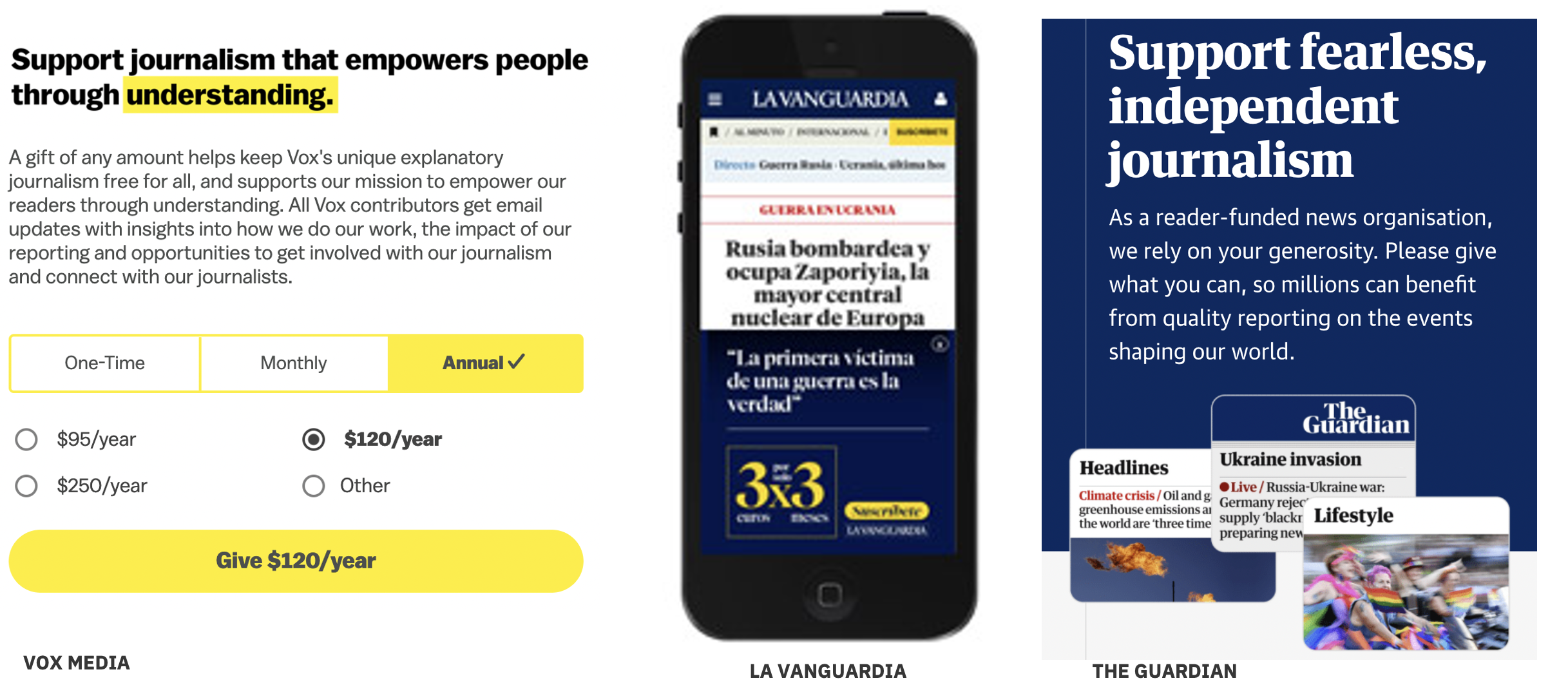
Bundling more value by building product extensions
An alternative approach has been to try to lock subscribers in through bundling additional features or complementary brands. The New York Times now offers a package that combines core news with its cooking app, games, and Wirecutter review service. Another option combines news from the Times with in-depth sports coverage from recent acquisition The Athletic. These packages, which have been fuelled by smart acquisition, are already at the heart of much of the subscription growth at the Times. CEO Meredith Kopit Levien says ‘bundled subscribers’ pay more over time and are less likely to cancel.5 Other publishers this year will be looking to copy this playbook6 through (a) developing premium product extensions like games, cooking, books, podcasts, and newsletters, (b) buying other successful subscription publishers that already own a niche, and (c) turning existing brands into a more complementary portfolio.
The New York Times explains how news feeds its wider portfolio and vice versa
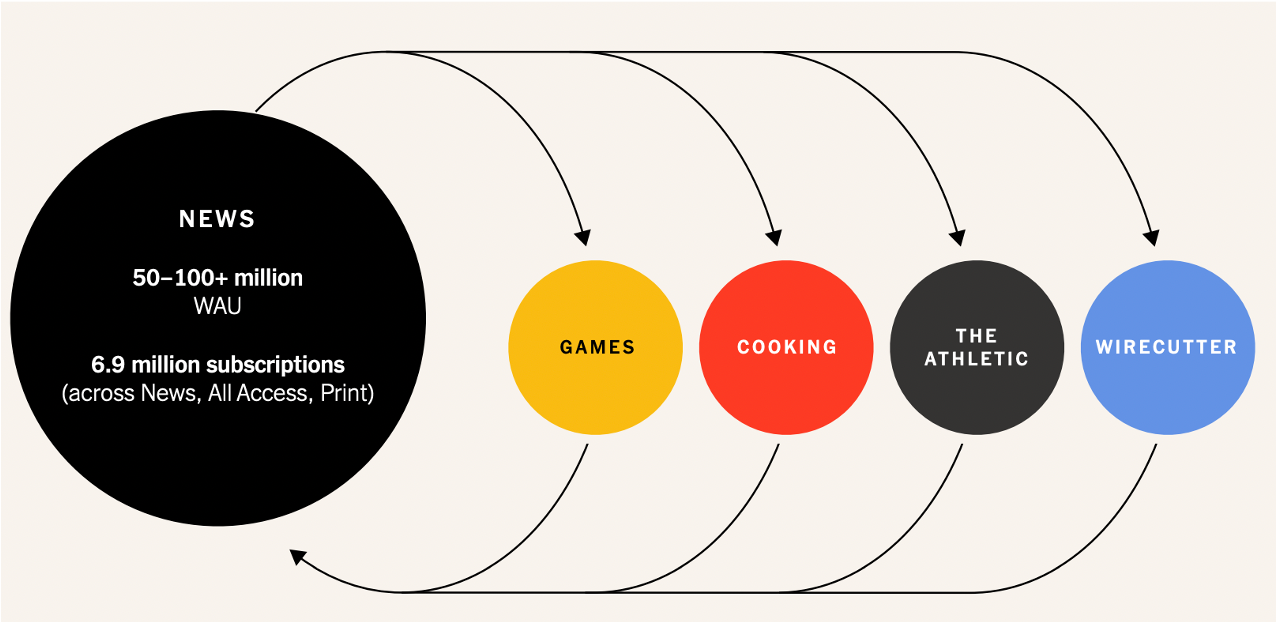
Le Figaro is one of many premium publishers adapting the New York Times playbook

In Norway, leading daily Aftenposten offers an all-access bundle that includes other Schibsted national and regional newspapers such as VG and Bergens Tidende, magazines, and premium podcasts via the PodMe application it recently bought into.
Diversified revenue remains a priority for publishers
While subscription (80%) remains the top priority in our sample, followed by display advertising (75%), most commercial publishers continue to say that multiple different revenue streams will be important to them this year. The Guardian, for example, combines subscriptions on its app with a donation model, digital advertising, revenue from platforms and foundations, and events too. The Financial Times, which is best known as a subscription publisher, also employs display and native advertising, runs a consultancy which advises other media companies, and has expanded its events business over the last few years, including the annual FT Weekend Festival.
Beyond paid content, the fastest growing income stream in recent years has come from funding from tech platforms. A third (33%) of our respondents say these payments for content licensing or innovation are now an important revenue stream – up 4pp on last year. This reflects behind-closed-doors deals that have been done by Facebook and Google in various territories, mostly as a result of government pressure, that have been criticised for favouring large legacy players. Google now pays more than 300 publishers for content across the European Union7 as well as in other parts of the world like Australia and Canada and Facebook has been paying up to $20 million to some large publishers for content it includes in its news section. On top of this, platforms now pay large sums to fact-checking organisations and news agencies around the world, as well for innovation schemes and research. The upshot is that the news industry continues to be unevenly and opaquely intertwined with big platforms in terms of both reach and revenue. Even as critical coverage of the tech industry continues, the public may wonder about the lack of transparency and the possible conflicts of interest.
What could happen this year?
Rows between platforms and publishers hot-up
Multi-year deals struck with publishers are starting to expire and Facebook’s parent company, Meta, has reportedly said it will not be renewing current arrangements in the United States, leaving some publishers with a revenue shortfall of tens of millions of dollars.8 The tech giant is looking to make cuts in the face of weakening advertising and has a range of other priorities including investing in the metaverse. In the face of government pressure, it has threatened to pull out from news altogether, which would up the temperature in what has often been a fraught relationship with leading publishers. Meanwhile, Amazon, Apple, Microsoft, and TikTok are all rapidly growing their advertising businesses, competing directly with news media, and it is not at all clear that relations between publishers and these platforms will be any simpler than between publishers and the ‘duopoly’.9
Publisher alliances aim to turn the tide
News organisations have long complained about big platforms taking much of the revenue but now the imminent demise of support for third-party cookies is threatening to make the situation even worse. Privacy-related changes threaten to reduce ad revenue further in the short term but are prompting publishers to start initiatives to collect their own (first-party) data that could be the basis for a more sustainable future. The Swiss OneLog system10 is now used by leading commercial publishers in the country including Ringier and TX media brands, as well as the public service broadcaster SRG SSR. This already accounts for around a quarter of the Swiss population with more growth to come.
Participating publishers say that ‘together we are stronger’ and that partnership can help them compete with platforms for attention and advertising. Portuguese publishers have been operating the Nonio common login for a few years and a similar approach is under way in the Czech Republic (Czech Ad ID). Unified logins or common identifiers can also allow participating publishers to share information about the browsing history of users – in an anonymous and privacy-compliant way – which helps them serve better-targeted advertisements and content, though that is not currently the plan for OneLog.
The Swiss OneLog system now has 2 million users


Premium ads and cleaner websites
Expect more publishers to follow the lead of Bloomberg News in abandoning all programmatic advertising (from January 2023) and focusing on direct sales. This ‘audience first’ approach is recognition that excessive ad density and poor user experience has contributed to the problems of the news industry by confusing users and undermining trust.11 Another indication of the shift to premium came with the historic GE takeover of the New York Times, a multichannel and multimedia campaign with a price tag to match.12
International growth on the cards
With home markets drying up, more companies are looking to expand abroad. Britain’s biggest news publisher, Reach, is preparing to launch websites in the United States for the Mirror and Express, recruiting around 100 new local journalists in the process. It’s also launching the Irish Star aimed at Irish Americans. This follows the success of the US Sun, owned by News UK which has more than doubled its traffic in the United States in the last year, and the Daily Mail which runs substantial newsrooms in New York and Los Angeles. This is part of a wider international trend where publishers such as Le Monde have also looked to acquire English readers as part of its mission to double its subscriber base by 2025.
3. Peak internet and the challenge of news avoidance
After decades of continuous growth, we have started to see a decline in the amount of time we are spending online, according to data from research agency GWI.13 Overall time with the internet is down by 13%, after record high usage during COVID-19 lockdowns, suggesting we may have reached peak internet. This is a highly significant change that could be a natural function of market saturation but the agency suggests that it may also reflect the anxiety people feel when using online and social media.
In terms of online news, it is hard to discern a clear picture. Around four-in-ten (42%), publishers say year-on-year traffic to their websites is up, with 58% reporting that traffic has been static or falling, despite a succession of important news stories from the Ukraine invasion, to rising energy prices, climate change, and in the UK, the death of the Queen.
In thinking about the reasons for flat or declining engagement, the vast majority of publishers (72%) are concerned about a trend highlighted in the 2022 Digital News Report where more users are actively avoiding the news. Digital News Report data show that this selective avoidance, often involving important stories such as politics, has doubled in some countries since 2017, because many people feel that media coverage is overly negative, repetitive, hard to trust, and leaves people feeling powerless.
Writing in the Washington Post, journalist Amanda Ripley calls for an approach that takes into account how humans receive the news to a much greater extent. She calls for journalism that explains the news better, gives people hope – and points to solutions rather than just identifying problems.14
In our survey we find almost universal enthusiasm for explanatory journalism (94%) and Q&A formats (87%) this year, but less enthusiasm around ideas like ‘solutions journalism’ (73%) – let alone moves to increase the number of positive stories (48%). This debate is often seen as a zero-sum game but our research suggests that audiences want journalists to continue to cover difficult stories and that they also want more inspiration, a broader agenda, and more fun.
Solutions and constructive journalism do seem to be picking up momentum with publishers. In Germany three media companies, Deutsche Welle, RTL News, and Rheinische Post have joined forces to create the Bonn Institute for Journalism and Constructive Dialogue with a mission to promote more positive debates and take more notice of journalism’s social responsibility. Meanwhile The Solutions Journalism Network has collected more than 14,000 examples of solutions reporting from around the world. The BBC runs a portal called Uplifting Stories, the Guardian has The Upside, but these stories rarely make front pages or become central to editorial meetings. Optimist Daily, The Good News Network, and Positive News are just a few examples of independent websites trying to redress the balance. Young people in particular seem to be embracing these approaches, with independent creators such as sustainability scientist Alaina Wood @garbagequeen attracting large audiences on TikTok for her positive climate news round-ups.
What could happen this year?
Reasons to be cheerful
Publishers will be integrating features that allow people to see more (or less) positive news. As part of its latest redesign, Pink News has included a mood control button as part of personalisation options. The LGBTQ+ publisher says around 25% of readers said they would prefer to read just uplifting news stories, in a recent survey. But for others it provides an option to take a break from negative stories when they need it.
Uplifting news from Pink, Optimist Daily and Good Climate News from Alaina Wood


Human centred news
Elsewhere look out for initiatives that put human stories at the heart of the conversation. The Human Journalism Network is a worldwide sharing platform for inspirational and high-impact stories. By sharing these stories across countries and languages the founders hope to develop more impact for less money at a time when on the ground reporting is under pressure. The Network started in 2021 by sharing content across eight Latin American countries, but will expand globally by early 2023, supported by the ICFJ, with content in English and Spanish.


More tools to help audiences take control
The Cold Turkey is a cross-browser extension that can block specific web pages, the entire internet, or your computer for set periods of time. It can be used for any activity that causes anxiety, not just news. Self-Control does a similar job for Mac users, while FocusMe reminds you to take regular breaks and can also be used by parents to limit children’s gaming time or web access. Forest turns the idea of self-control into a game with trees and plant flourishing when you stay away from your phone. You can earn points to help plant real-world trees.
4. Step change in news media’s coverage of the climate emergency
The last year has seen another spate of extreme weather events across the globe, including severe heatwaves in China, famines in Somalia and Ethiopia, wildfires in California, and drought across Europe – not to mention catastrophic flooding in Pakistan. The news media are routinely criticised for covering these stories breathlessly, without joining up the wider dots or following through on the lasting consequences. Others argue that the media have too often treated climate as a discrete subject, rather than as an integral part of wider political and economic decision-making.
Moves are afoot to change this with enhanced specialist teams, and new strategies for sustainable journalism, according to our survey results (below). Around two-thirds of our sample (63%) of news executives now rate their own coverage as good, even if many also admit that engaging audiences with the often-depressing outlook for the planet can be a tough sell.
In our survey half of respondents (49%) say that they have created a news climate team with just under a third (31%) hiring more staff to cover different aspects of the crisis. Amongst these are National Public Radio and the Washington Post, which announced in November 2022 that it would be tripling the size of its climate team to 30 people. Enhanced coverage includes Climate Lab, a section that uses data and graphics to show the impact of global heating, a climate advice columnist, and consumer guides to help consumers navigate choices about how to live sustainable lives. There’s also a new part of the website focusing on solutions, including potential technological breakthroughs. Many other publishers have launched podcasts and newsletters this year.
Three in ten (30%) say they have developed a strategy to improve climate coverage. One example comes from the Norwegian public broadcaster NRK which aims to do more than just explain the science. It also plans to engage audiences with humour and heart and to ensure that there is real accountability for pledges made by politicians, businesses, and environmental organisations.15 Meanwhile The News Movement (TNM), a start-up aimed at creating content for younger audiences, is building content around the idea of a ‘Better Planet’, bringing together climate, biodiversity, solutions/innovation, and the impact of food and diet. This approach came out of detailed audience research into the subjects that interested the target group.
A third of news executives (33%) also say they have taken steps in the last year to improve sustainability. Schibsted, for example, has been working to reduce the carbon footprint of its reporting and production and this is backed up by an annual sustainability report with a dedicated unit working on these issues across the company. Around a quarter of our survey respondents (23%) say they have embarked on training programmes to increase awareness, with more than four in ten (44%) recognising that elements of the climate story need to be part of wider coverage across the newsroom. In Austria, publishers recently got together to create a set of guidelines for newsrooms including the accurate use of language, coverage of solutions as well as problems, separation of fact and opinion, and the creation of resources and structures to support better coverage across disciplines.16 Cross-country communities are being developed, including our own Oxford Climate Journalism Network (OCJN) to share best practice.17


5. Tech platforms suffer from overreach, hubris, and new competition
Twitter laid off three-quarters of its workforce and alienated its biggest advertisers this year. Meta’s stock fell by about two-thirds (66%), with some staff complaining that Mark Zuckerberg’s obsession with the metaverse was in danger of killing the company. Few could have imagined such seismic developments just a year ago but Big Tech has suffered a series of reverses linked to a slowdown in digital advertising, privacy changes on Apple’s iOS platform, and falling consumer interest in many of their products.
Facebook share falls Jan 2022–Dec 2022
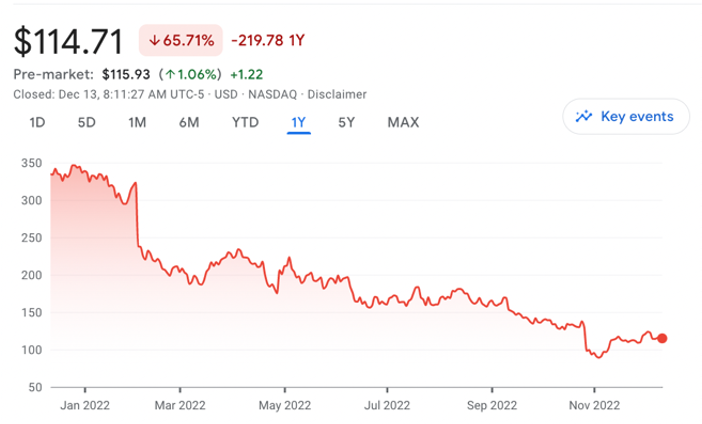
For younger users in particular, we find clear evidence that first-generation social networks are losing their appeal in favour of fun-filled apps like TikTok.
The dramatic rise of TikTok, which is owned by Chinese media giant ByteDance and has around one billion regular users, is not just existentially worrying for Facebook, which has seen its user base shrink and age by five years at the same time. Google is already seeing some of its lucrative search traffic peel away, with ad revenue well below market expectations.18 Amazon also fears TikTok’s potential as a shopping and payment platform.
Meanwhile Elon Musk has alienated journalists and many others with his unpredictable behaviour following his $44bn takeover of Twitter. Concerns have mounted over the sacking of staff responsible for platform integrity, the suspension of critical journalists from the platform, and the flip-flopping over the role of blue ticks for verified sources. ‘It seems Elon lacks media literacy, has taken a turn for the conspiratorial right, and – at worse – is driving Twitter into the ground to become a backwater which advertisers are rightly scared of,’ says Tom Grundy, Editor-in-Chief and founder of the Hong Kong Free Press.
One research group has predicted that Twitter will lose more than 30 million users in the next few years if the experience worsens.19
Against this background it is not surprising to see publishers in our survey saying they will be putting less effort into both Facebook (-30 net score) and Twitter (net score -28) and much more effort into TikTok (+63 net score) – that represents a 19-point increase compared with last year.
These data suggest that publishers will be prioritising video platforms like TikTok and YouTube this year amid evidence that these are good ways to engage younger users. A recent Reuters Institute report shows that around half (49%) of top publishers across dozens of countries are now active on TikTok, despite concerns about Chinese ownership and the security of user data.20
Journalists remain ambivalent about Elon Musk’s Twitter
Despite their reservations about Elon Musk, many journalists find it hard to contemplate a future without Twitter. It remains a one-stop shop for real-time news, as well as a good way to keep in touch with specialist sources, and to promote personal brands. Overall, the majority of our respondents (51%) say it would be bad for journalism if Twitter were to implode. ‘Twitter has brought many benefits to journalism in finding stories, getting testimonies and accessing information,’ points out Clara Jiménez Cruz from the fact-checking site Maldita.es. Others stress its historic role in giving space to alternative sources of news: ‘In my country Twitter is an important space of freedom to reach audiences that don’t have another source of information,’ says Luz Mely Reyes, General Director at the independent Venezuelan outlet Efecto Cocuyo, who runs a successful streaming show on Twitter.
By contrast, around one in five (17%) think it would be good for journalism, with some respondents suggesting that far too much time is currently spent listening to unrepresentative elites: ‘In Ecuador journalists waste too much time on Twitter,’ says Isabela Ponce, Chief Editor at GK.City. ‘Audiences think reporting things on the platform is journalism and it is not,’ she says.
Others feel that, while Twitter has become a key tool for journalists, it has also reduced traffic to mainstream websites, contributed to the spread of misinformation, and polluted debates: ‘The culture of Twitter – thoughtless outrage – has spread to media, making it more shrill,’ argues Edward Roussel Head of Digital at The Times and The Sunday Times. ‘I will miss it on a personal level, but I think it would actually strengthen serious journalism,’ says Peter Wolodarski, Editor-in-Chief at Dagens Nyheter in Sweden.
In our survey, few respondents could see an obvious replacement. Some have migrated to Mastodon, but most describe an empty and fragmented experience. When forced to make a choice, four in ten (42%) selected LinkedIn, a network that has invested in more editorial staff and new features to drive news conversation on the platform in recent years.21 Beyond that, respondents say they might mix different platforms for discovery and distribution but there is no one-stop shop: ‘There is no replacement for the “old” Twitter. The idea was genius. Mastodon is not a replacement,’ says Wolfgang Vichtl, Chief Correspondent at ARD in Germany.
This year we’re likely to see the emergence of a few Twitter alternatives. Many will be watching Post, a network created by former Waze CEO Noam Bardin. Still in beta mode, it has pledged to create a space for ‘civil conversations’ and is hoping to bring premium publishers onto the platform with some kind of micropayment system.22
For many the chaos at Twitter in the last few months is an illustration that current social media models are broken and that debate in the public sphere should not be subject to the whims of a few billionaires in Silicon Valley. Some are even asking if the era of mass social media is over.23 Connecting the world in one town square seemed like a good idea at the time, but people have been drifting away for some time to private or semi-private communities where conversations are less toxic and more meaningful. Community-building tools like Discord are part of that trend as is Mastodon. Ethan Zuckerman, Associate Professor at the University of Massachusetts has been making the case for smaller, decentralised networks, that have the user’s interests at heart.24 He and his team at MIT have experimented in the past with a browser extension that gives users more control over their feeds from multiple networks and we’re likely to see more discussion of these ideas in the coming year.
What else could happen this year in platforms?
Facebook completes its break-up with news
Facebook is reorientating itself towards mobile entertainment and commerce – and even further away from news this year – as it looks to revitalise engagement on the platform. Human curation of Facebook News has already been pulled, Instant Articles are set to be withdrawn in April 2023, and a number of those recently made redundant were in the Facebook Journalism Project or in the news partnerships team. Few would be surprised to see the News tab disappear entirely in the next few years. Facebook says that less than 3% of what people see in their feed are posts with links to news and that it doesn’t make sense to invest in areas that don’t align with user preferences. The cost of doing business with the news industry may be another factor: ‘In many markets, the complexity of our partnerships is growing because of government regulation around news,’ wrote Meta’s Campbell Brown when explaining the company’s pivot toward digital creators and short-form video.25
A year of social search?
A Google executive recently revealed that 40% of young people now go to Instagram or TikTok, rather than use their own search or maps products when they are looking for a place to eat.26 Instagram searches are geared to help people to stay updated on trends as well as travel and fashion, while Snapchat’s Maps are optimised for local business. This shift is also happening in the news, as younger users turn to using social discovery features such as hashtags and collections – as well as search itself – to find out about the latest developments in Ukraine. The example below (left) shows how poorly represented mainstream media are in these results so a key focus for publishers will be to better optimise news and explainer content for these environments. Clearer branding may also be needed to ensure that reliable publisher content stands out in these result sets.


TikTok starts to look more like other social networks
TikTok’s ‘For You’ feed, which surfaces the most entertaining (and informative) content from across the network, has been a key differentiator during its growth phase but now it is planning to add features that allow closer connection with friends. TikTok Now captures what you are doing at a particular moment using your phone’s back and front camera – essentially a direct copy of functionality of the Be Real app. TikTok is also expanding the length of its videos and considering support for landscape aspect ratios27 to compete with YouTube and open up more advertising possibilities for creators.
TikTok Now is one of a number of social features that aim to drive more creativity


Increased regulatory pressure on TikTok
As the network’s influence grows, we’ll see more government and public scrutiny of its algorithms and impact on society. Recent research by Newsguard suggests that new users were typically exposed to misinformation about the war in Ukraine within 40 minutes of using the platform.28 TikTok has also struggled to deal with the volume of misleading election content in the last year, including those in Germany, Brazil, and the Philippines.29 Partly in response to these critiques, TikTok has set up election hubs containing official and verified sources, increased moderation, and labelled some news outlets as ‘state sponsored’. Beyond misinformation, we can expect more attention on the amount of data TikTok collects and whether Chinese authorities have access to it30 – especially if geopolitical tensions deteriorate further. Mathias Döpfner, CEO of media group Axel Springer, has called for all democracies to ban the app, and several Republican politicians in the United States have made a similar case. India has already banned TikTok for its 200 million internet users over security concerns and the UK parliament recently shut down its account.
Platform regulation begins to bite
The introduction of the Digital Services Act (DSA) and Digital Markets Act (DMA) this year in the European Union will put new limits around the activities of the biggest tech companies on issues ranging from harmful content to unfair competition. Full implementation will take many years but early test cases in the courts should set the tone and the hefty potential penalties involved will make Elon Musk think as he contemplates pushing Twitter towards more edgy speech. By contrast the UK has watered down proposals in its upcoming Online Safety Bill to force tech giants to remove content that is ‘legal but harmful’ from their platforms after campaigners and lawmakers raised concerns that the move could curtail free speech.
Elsewhere, legislation that constrains what can be said in social media is already on the statute books in many countries, including authoritarian states and those where democracy is fragile. In our survey over half of our respondents said they were worried about the implications, including for journalism.
All eyes this year will be on India, where new rules will give government control over the content moderation decisions that social media companies make for the first time.31 Critics argue that this will incentivise platforms to remove or suppress any speech unpalatable to the government, or those exerting political pressure. Platform companies’ content moderation policies and their practical enforcement have already led to instances where the work of journalists have been restricted in problematic ways.32
6. Format innovation: the shift to audio and video continues
One of the underlying megatrends in digital has been the explosion of formats and channels that publishers can use to reach consumers. Owned and operated websites are now only one of many ways of engaging audiences. Better data connections have opened up possibilities beyond just text and pictures and smartphone adoption has accelerated the use of visual journalism, vertical video, and podcasts.
In our survey, the majority of publishers say that they will be focusing on podcasts and other digital audio (72%), email newsletters (69%), and digital video (67%) this year. Interest in short-form video production has grown (+4pp) partly in response to the changing social media strategies detailed in the previous section. By contrast there is less interest in developing applications for the metaverse or for voice assistants, where journalism ‘use cases’ have proved hard to identify.
Amid the unpredictability of social media, most publishers see investing in podcasts and newsletters as the best way to build a deeper connection with audiences and to encourage them to come back more frequently. With an overload of general news content, publishers are increasingly looking to develop more unique or specialist content that can be bundled with existing subscriptions (as we found earlier) or can be charged for separately. In both cases we are starting to see a more strategic ‘portfolio approach’ emerging with a focus on personality hosts, intelligent curation, and a lighter tone. Examples include the Due Diligence Newsletter from the Financial Times which looks at the latest dealmaking, and the HotPod newsletter from Vox Media which looks at the business of podcasting. Other publishers are looking to build cross-platform franchises such as Tortoise Media’s Sensemaker, which is available in both newsletter and podcast formats. Publishers like Tortoise Media have pivoted to a newsletter and audio focus and say that these have helped them bring in significant numbers of new members.33
What else might happen this year in digital audio?
‘Reporter reads’ get a human voice but is it the real thing?
The New York Times is due to launch its new audio product early in 2023 and this will include a significant upgrade on the idea of ‘reporter reads’. Each story starts with a personal intro from the reporter themselves with some biographical material and then a lightly illustrated treatment that may include some sound design or illustrated clips. This human approach doesn’t scale easily, but is a response to disappointing results from stories read by synthetic voices on many publisher sites and across many non-English languages.
But artificial intelligence (AI) voices are getting smarter and it is now possible to clone a journalist’s voice with extraordinary accuracy. Aftenposten, one of Norway’s largest news publications, recently cloned the voice of its podcast host using AI technology while News24 in South Africa has also trained its systems with the voice of a popular actor for its news and feature stories.34
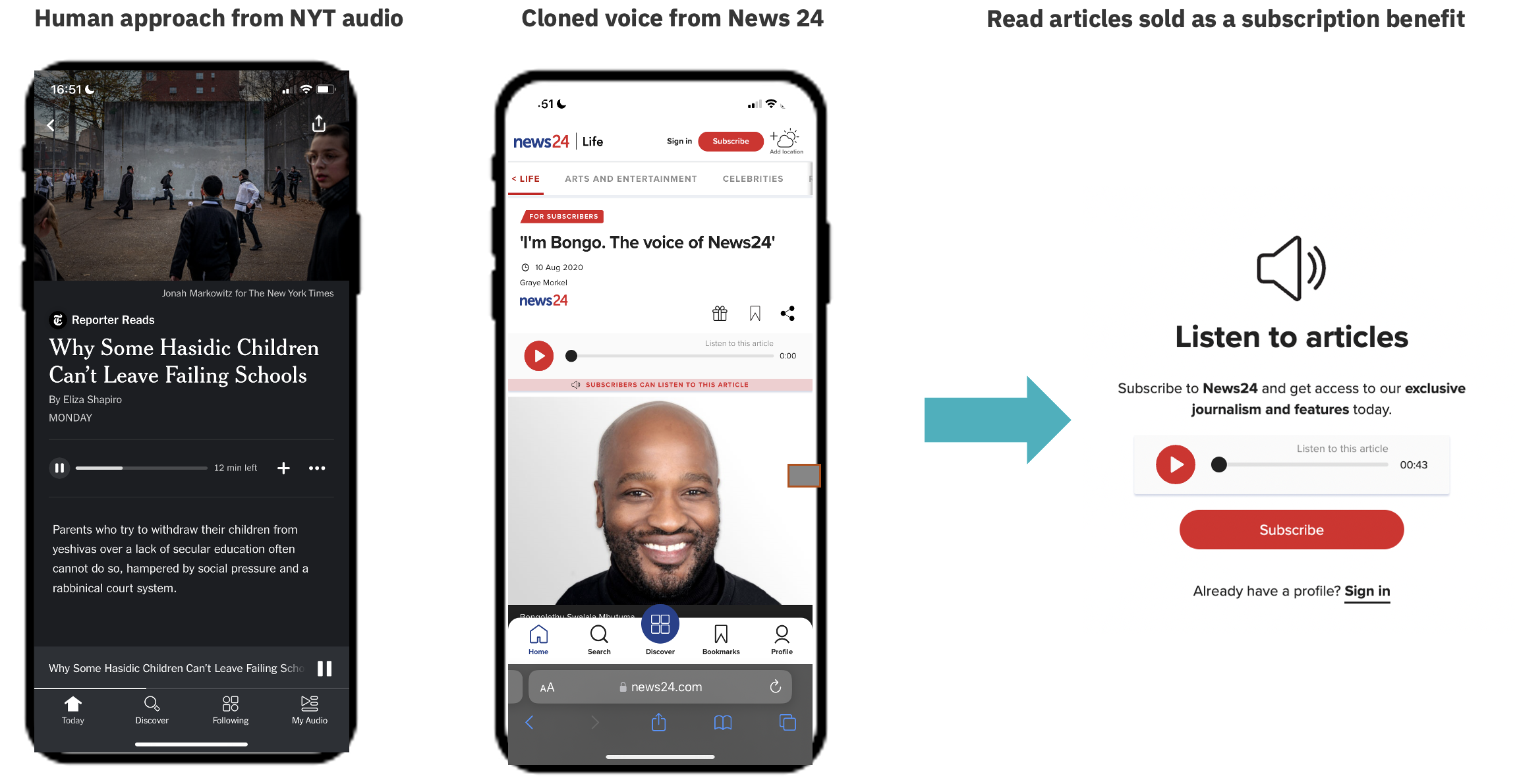


Subscription publishers consistently tell us that those that consume audio are amongst their most loyal customers and spend more time with their products.
Will advertisements spoil the podcast experience?
We may have reached saturation point in terms of the number of podcasts, but not in terms of revenue. Ad revenues in the US are set to double to $4bn by 2024, according to the Interactive
Advertising Bureau and PricewaterhouseCoopers.35 This is mostly related to better ad tech rather than higher listening figures. Most ads in the US are now dynamically inserted and can be targeted at different ages, genders, and locations as well as content types. In the UK some of the biggest news podcasts, such as The News Agents with Emily Maitlis and Jon Sopel, and The Rest is Politics with Rory Stewart and Alastair Campbell, should also be able to capitalise on these trends but there is a danger that growing ad density and a less personal approach could damage the podcast experience. Expect to see premium ‘ad-free’ options becoming a standard part of podcast offers this year.
What else might happen this year in newsletters?
Local newsletters boon
Newsletters don’t require constant updates and off-the-shelf tools such as Substack can help entrepreneurs to create content and make money with a few clicks. These low-cost models have provided a blueprint for how local media could develop in the future. In the United States, 6AM City and Axios Local have pioneered this approach, with 6AM City reaching around 1 million subscribers across more than 20 cities, with expected revenue of more than $10m in 2022.36 In the UK, independent local news outlets the Manchester Mill, Liverpool Post, and Sheffield Tribune have all reported encouraging growth in the number of paying email newsletter subscribers. Traditional outlets are getting in on the act too, with regional publisher Reach setting up an Email Innovation Lab with the help of Google funding. This will experiment with passion-based newsletters centred on communities of interest around Bristol and new borough-based newsletters in parts of London.
6AM City now reaches 1 million subscribers in more than 20 cities


Platform newsletter choices narrow
Twitter has discontinued its newsletter product Revue and Facebook is also shutting Bulletin, but one alternative gaining traction is LinkedIn. The platform makes it easy to sign up brand loyalists and integrates comments and other useful features. The BBC’s Worklife 101 brand is an obvious fit and has almost 1.8m subscribers along with business-focused publications such as Forbes. The French daily L’Opinion has also been experimenting with daily news headlines.37
LinkedIn Newsletters connect with professional users



7. Product direction is clear but frustration remains over pace of change
A few years ago, we detected in this report significant tension between editorial, business, and product functions, as well as a lack of understanding about the role of product in a news organisation. But things are starting to change, with more confidence that the right products are being developed (54% agree), a clear process for improving and optimising existing products (54%), and a culture of learning from mistakes (52%).
But there is less satisfaction that products and features are being developed quickly enoughi– just 41% feel their company does a good job in this respect. Even fewer (23%) feel news organisations are good at shutting down old products that have less value, which tends to slow down progress elsewhere. This is in sharp contrast with tech companies like Meta and Twitter that ruthlessly kill features that aren’t working, as we saw in the previous section.
The Financial Times is one organisation that is trying to speed up the product development process. FT Edit, a curated selection of some of the best features, is the first new product that the title has launched in a decade and represents the start of a more experimental phase where new ideas will be launched and tested with real users much more often.38
Another example of a product that has been spun up using agile techniques is the Washington Post’s Newsprint, a personalised review of the journalism consumed in the previous year. Inspired by Spotify’s highly successful Wrapped feature, which fills timelines at the end of each year, the product team pivoted the idea towards providing insights on the reader’s personality after initial feedback showed they were less interested in looking back at what they’d already read.39
Examples of iterative product development from the Washington Post and FT
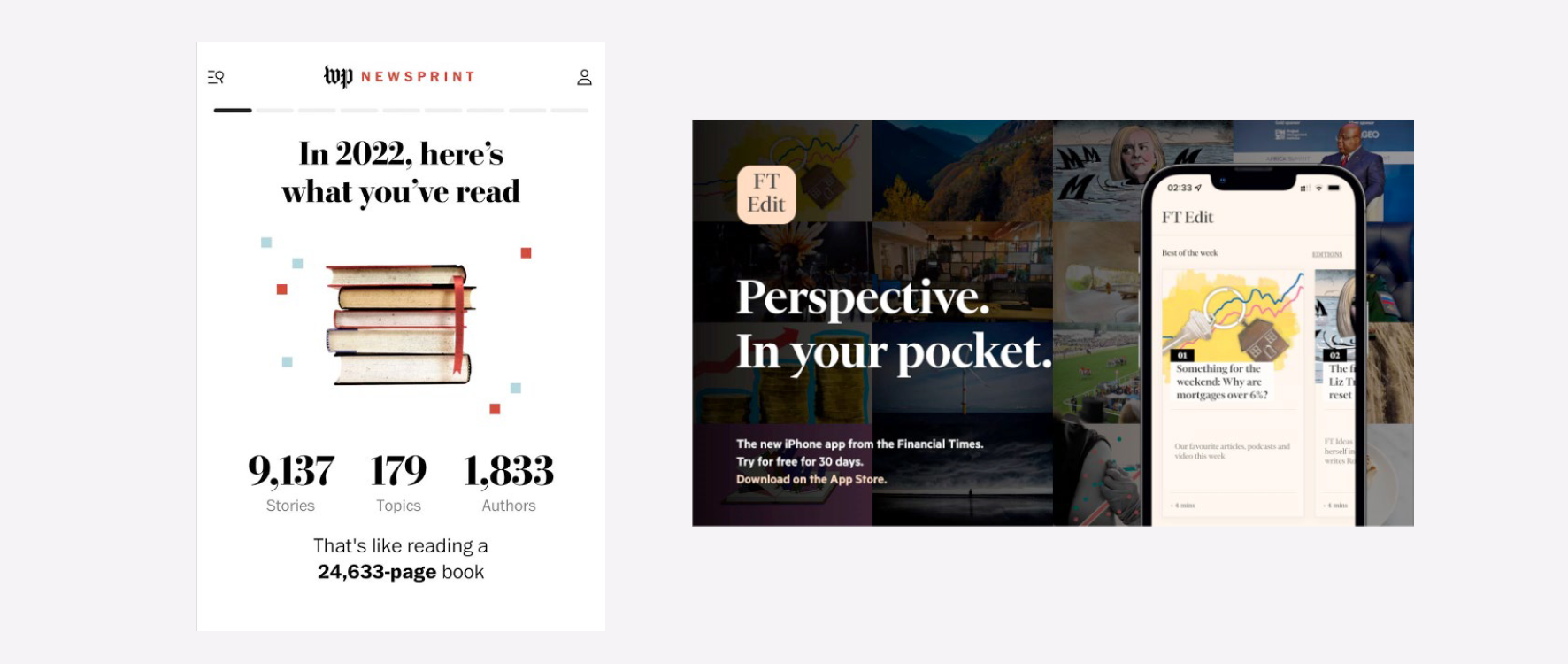
For some, the biggest barrier to achieving more speed is retaining technical and product staff, given the competitive nature of the sector. But overall, we detect a much more audience-focused approach to product development this year. Instructions from senior managers to ‘just build it’ have been replaced by processes that identify ‘the problem this solves, and for whom’, according to one senior product director at a leading UK publisher. Even so, these more evidence-based approaches can often add time and continue to create tension: ‘There’s still a divide between editorial and product staff which is our greatest barrier to achieving more speed and working together on tough priorities,’ says a digital leader from a European public broadcaster.
‘Audience needs’ models help focus development
Another key trend is the way in which product and editorial teams have been embracing ‘user needs’ models and ‘jobs to be done’ methodologies to help identify opportunities. These processes ask searching questions about what role publisher products can play in a world of abundant media choices. They drill down, for example, into specific problems that audiences have and think about different ways these could be solved. When introduced at the BBC a few years ago,40 the resulting audience models led to commissioning of more content that explained complex events and inspired people and less news that just kept people up to date. These approaches are in some way a response to the challenges around news avoidance we discussed in Section 3, which is one of the reasons that they are resonating with publishers such as the New York Times on both the content and product side. Brought to life in this unofficial user needs map by consultant Dmitry Shishkin,41 it is easy to see how recent acquisitions like Wordle and The Athletic have been shaped by this type of thinking.
Unofficial user needs model of the New York Times

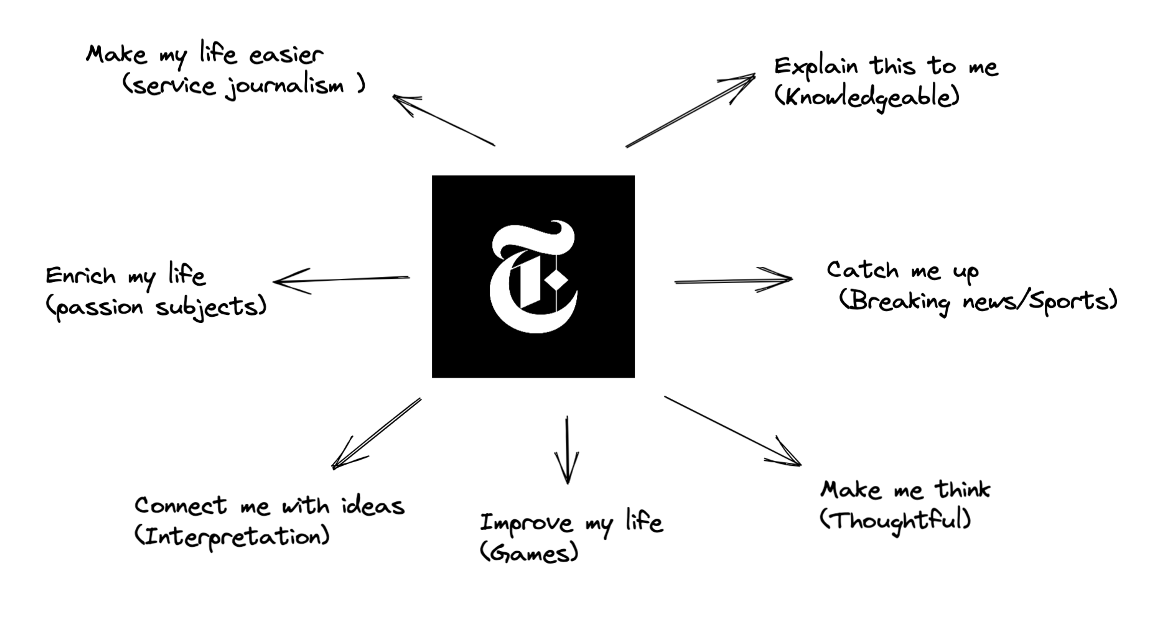
Similar experiments have been developed by other publishers including Conde Nast, Vox, The Atlantic, and Globo in Brazil, with content often tagged in CMS systems to allow continuous measurement of how different content types are performing.42 This year we can expect more examples of user needs models driving new product development, not just content commissioning.
8. Breakthrough year for artificial intelligence and its application for journalism
AI chatbots have been widely and justifiably mocked in recent years,43 but the arrival of ChatGPT, from OpenAI, has transformed the debate. Its speed and capabilities are awe-inspiring and frightening at the same time. While the underlying models have been around for some time, ChatGPT has turned these into an accessible prototype that gives a real sense of where AI may be heading. It can tell jokes (but has been trained not to tell racist or sexist ones), come up with plots for a film or book, write computer code, and even summarise the challenges facing local journalism in a few sentences (below).

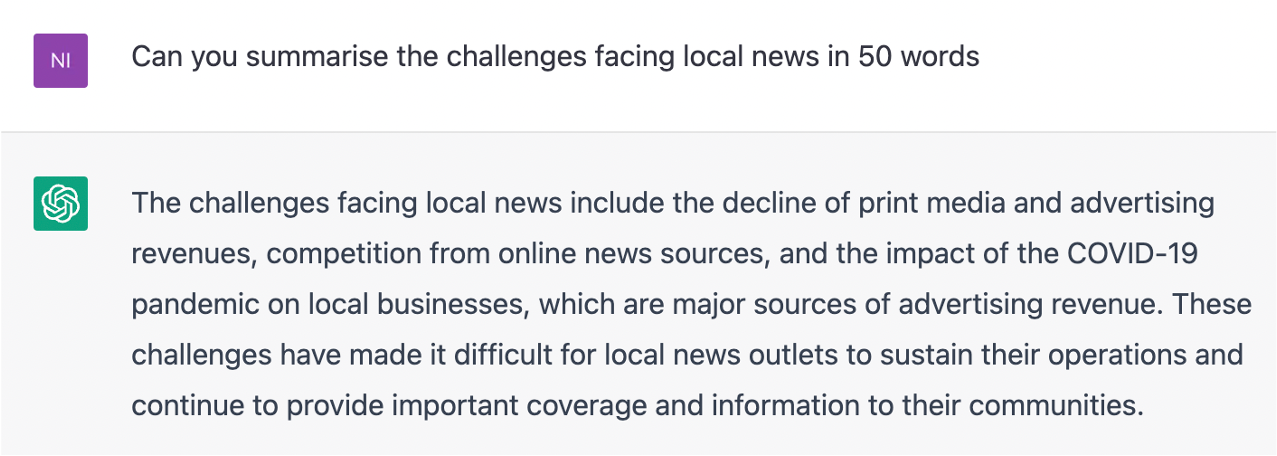
Some view ChatGPT as one of the biggest technological advances since the invention of the internet and is part of a wider trend called ‘generative AI’ that enables computers to create not just words but also pictures, videos, and even virtual worlds from just a few text prompts.
Here is an image of a journalist, in the style of a Raymond Chandler novel, filing a story from a Pacific Beach using a laptop – created in seconds using the AI tool MidJourney.


The key point is that generative AI enables computers not just to make existing processes more efficient, but use a range of existing assets to create something new. For the journalist in that Raymond Chandler novel, this raises existential questions but also opens up a range of new possibilities.
This year we’ll start to see more of these tools being opened up to creators, journalists, and others, allowing us to create new versions of ourselves, of others, and the world around us. Lensa is an app that allows you to magic avatars of yourself and remove unwanted objects from any picture with ‘no skills required’. These apps have already been criticised for stealing from artists, using predatory data-sharing practices, and promoting sexualised stereotypes, but that won’t stop them taking over social media timelines this year.
Magic avatars will take over social media timelines this year

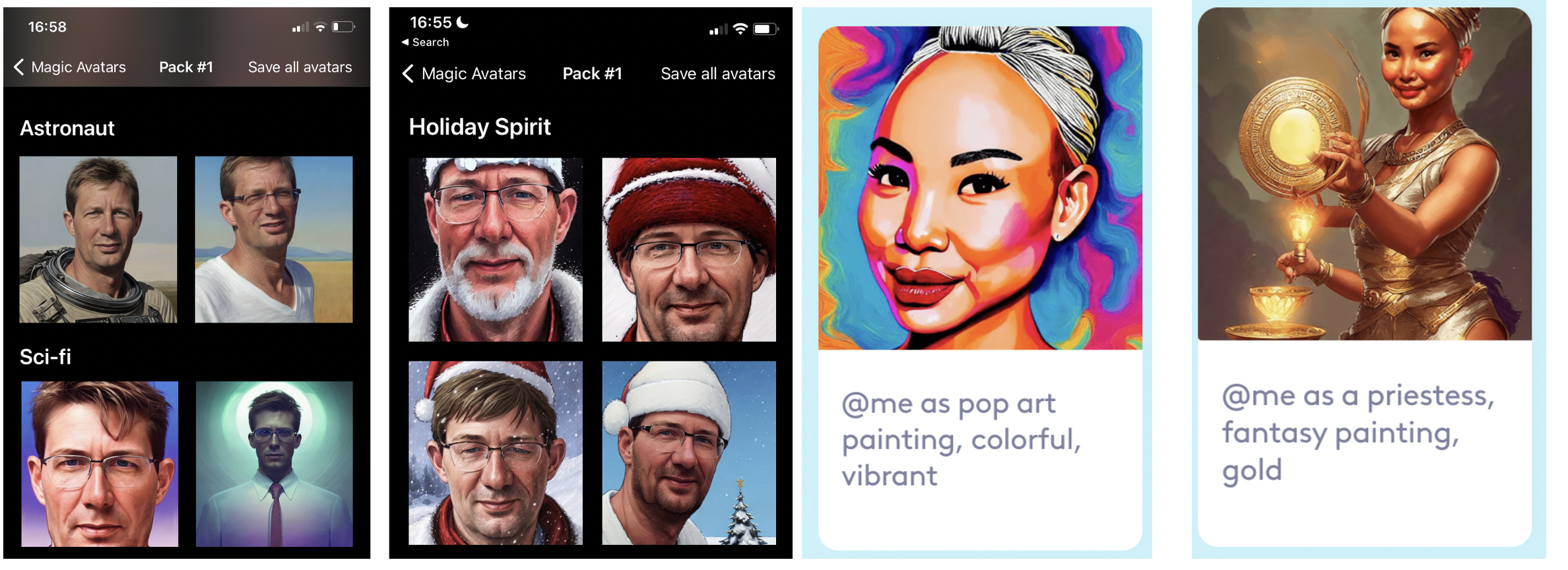
The implications for journalism are not entirely clear but tools like MidJourney and DALL-E are already being used to create illustrative art for articles and blog posts. More ambitiously, Semafor, the recently launched US start-up, has created several videos under a Witness strand where personal testimonies from Ukraine are powerfully illustrated by AI animations in the absence of real footage. But similar deep learning models can also be used to create propaganda, notably a ‘deep fake’ of President Zelensky telling Ukrainian citizens to lay down their arms soon after the Russian Invasion (below right).
Semafor has used AI to animate the Ukraine war, but similar tech can be used for deep fakes



All this is likely to lead to an explosion of automated or semi-automated media in the next few years – for good or ill (the research firm Gartner estimates it will account for 25% of all internet data). It will be easier than ever to create ‘good looking’ and highly plausible multimedia content, but it will also be harder than ever to separate what is real from what is fake, misleading, or doctored.
Other ways in which AI is being used in news organisations
In our survey, news executives talk about different ways in which they are using AI technologies such as Machine Learning (ML) and Natural Language Processing (NLP) to make existing production processes more efficient: ‘Summaries, text to speech, and image recognition leading to automated tagging and subtitles’, are some of the examples mentioned by Mathieu Halkes, Head of Product at Schibsted. ‘[There are] more and more use cases we see and apply every day’, he says.
AI transcription tools are now routine in newsrooms, with Danish digital-born outlet Zetland developing a speech to text transcription service aimed specifically at journalists and designed to work with smaller languages that big corporate products have failed to support. Good Tape is built on top of OpenAI technology and is currently free to use. Meanwhile, in Finland, the public broadcaster Yle has been able to start a service for Ukrainian refugees with news being automatically translated by machine before being checked by a native speaker.44 During the pandemic, Yle was also able to provide information in Somali, Arabic, Kurdish, and Persian.
Others hope that AI can help deliver better personalisation and improve content recommendations to help increase engagement. The Sophi tool was developed by the Globe and Mail in Canada, where it has automated the vast majority of its web homepages, allowing editors’ time to be used more productively and driving a 17% increase in click-through rates. The product is now being offered to other publishers. AI-driven tools like Sophi are also used to manage social distribution tasks such as headline optimisation and the best time to post.
When it comes to recommendations, around a quarter (23%) of our respondents say they are now using AI regularly, with 5% of early adopters making it a big part of what they do.
Sophi automates homepages, Yle in new languages, and Zetland offers transcription


The Newsroom is a start-up (still in beta) which uses AI to automatically identify and write summaries of the top news stories of the day, as well as summarising background context and providing links to related stories that are clustered by political perspectives. Although AI does the heavy lifting, all copy is checked and if necessary modified by a journalist.
The Newsroom – stories written by AI but checked by humans with automated context


The debates over automation in journalism are not straightforward. Many welcome the capability to make non-journalistic tasks more efficient, but at the same time worry that cheaply produced synthetic media and semi-automated content could further commoditise news and undermine trust. One respondent from a leading quality news company argues that in these circumstances human curation becomes an even more important differentiator. ‘We want to apply AI fundamentally to enhance manual curation not to replace it. All our work in this area is rooted in an understanding of the value manual curation brings to our readers and how it differentiates us from platforms with a host of problems around automation and curation.’
What else might happen this year in AI and journalism?
Broadcast companies embrace virtual presenters
Deep Brain AI, a technology company based in South Korea, creates digital copies – or digital twins – of popular TV news anchors and these now make regular appearances on mainstream channels in Asia. MBN and Arirang in Korea and BTV and CCTV in China are using the technology to help save costs and enhance the presence of the most popular presenters. The company is now looking for customers in the United States where TV companies are under pressure to do more with less. One likely ‘use case’ is for on-demand weather, where an AI model can be created of a popular forecaster including their favourite phrases and expressions, and then updated videos can be created for any location whenever the underlying data change. These models can also be combined with ChatGPT functionality to create a virtual chat bot answering questions about an election, for example, by a political correspondent’s digital twin.
Virtual anchors coming to a screen near you?


 Pictures: Deep Brain AI
Pictures: Deep Brain AI
Debate over regulation of AI hots up
As these opportunities become more real, so do the ethical and regulatory dilemmas. Deep fakes have already been used to create non-consensual pornography, commit fraud, and fuel disinformation campaigns. Discussion about regulation is ongoing, and the EU is proposing an AI Act that would ban ‘unacceptable’ uses of applications that violate people’s fundamental rights and safety – even if in practice these will be hard to identify and enforce. In the meantime, journalism could take the lead in making its use of AI more transparent. We can expect more publishers to publish ethical guidelines covering the key areas which range from photo-improvement or manipulation to transparency and copyright. Open AI is working on digital watermarking responses and better labelling that could also help build trust in positive uses of these technologies.
9. Conclusion
The prevailing mood in the news industry is one of uncertainty and some concern about what the next year might have in store. The economic indicators do not look good, with rapidly rising costs and a squeeze on household spending expected to continue for some time. Issues such as news avoidance and news fatigue are widespread at the same time as some social platforms seem to be imploding or turning away from news, and emerging platforms seem largely uninterested in it – making it even harder to attract new customers.
Companies that have already completed their digital transition and have a robust subscription businesses or diversified revenue remain in the best position to ride out the storm, but those that are over-reliant on print or advertising have a tough few years ahead. In many parts of the world, this economic weakness will make some news organisations even more dependent on government advertising or well-connected proprietors, undermining their ability to hold the rich and powerful to account. Elsewhere we can expect extensive layoffs as well as a spate of mergers, acquisitions, and partnerships as industry tries to cut costs and bundle value in new ways. Industry consolidation sometimes creates more problems than it solves, but at its most effective, we’ll find companies looking to run portfolios of distinctive and complementary brands with a greater focus on specific audience needs and segments.
These shocks may also open up more radical thinking about the way news can be created and what a digital news organisation should look like. Lower cost models are emerging centred around distributed newsrooms and tools, helping to fill in gaps in local news provision for example. Some entrepreneurial journalists and news creators are pivoting to newsletters and podcasts, which enable deeper connection with specific audiences without the overheads that weigh down many traditional news organisations, but these are largely additional services that benefit those already interested in news.
Younger audience behaviours such as social search and vertical video are also helping to upset the old order in Silicon Valley. Together with the unpredictability of Elon Musk, this has reminded us that it would be a mistake to take these platforms for granted. Tech companies remain focused on how they can respond to TikTok and the creativity it has unleashed along with the threat to their business models. Long-standing platform companies including Amazon, Apple, and Microsoft are all focused on growing their advertising business. Concerns about the news industry are likely to take a low priority.
At the same time, we are on the cusp of a new wave of disruption as artificial intelligence technologies start to impact on the real world, driving greater efficiency and automation on the one hand, but also enabling content to be remixed in surprising and unpredictable ways. This will help media companies do more with less, as well as open up opportunities in the creation and distribution of smarter content. But it will also bring new dilemmas about how these powerful technologies can be used in an ethical and transparent way.
Some media companies are still on a journey to become more digital, but that increasingly feels like yesterday’s debate. The next few years will be defined more by how we can transform our digital content into something that feels more relevant and more useful to different groups. In this process new technologies can be our ally in tailoring content more precisely to different audience needs. But at the same time, journalism will need to emphasise its human qualities and its track record of delivering trusted content if it is to stand out from the flood of automated and synthetic media that threatens to overwhelm internet audiences.
Survey methodology
303 people completed a closed survey in November and December 2022. Participants, drawn from 53 countries and territories, were invited because they held senior positions (editorial, commercial, or product) in traditional or digital-born publishing companies and were responsible for aspects of digital or wider media strategy. The results reflect this strategic sample of select industry leaders, not a representative sample. Typical job titles included Editor-in-Chief/Executive Editor, CEO, Managing Director, Head of Digital, Director of Product, and Head of Innovation. Over half of participants were from organisations with a print background (53%), around a quarter (24%) represented digital-born media, a fifth (20%) came from commercial or public service broadcasters, and a further 3% came from B2B companies or news agencies. These proportions are similar to previous surveys.
The 53 countries and territories represented in the survey included Australia, New Zealand, Taiwan, Hong Kong, Singapore, Thailand, South Korea, Vietnam, Japan, Nigeria, South Africa, Zimbabwe, Ecuador, Costa Rica, Nicaragua, Venezuela, Uruguay Mexico, Brazil, Colombia, and Russia, but the majority came from the UK, US, or European countries such Germany, Spain, France, Austria, Finland, Norway, Denmark, and the Netherlands as well as Poland, Hungary, Slovakia, Latvia, and Ukraine amongst others.
Participants filled out an online survey with specific questions around strategic and digital intent in 2023. Over 90% answered most questions although response rates vary. The majority contributed comments and ideas in open questions and some of these are quoted with permission in this document.
The author is grateful for the input from a number of publishers, academics, and industry experts when preparing this report via background conversions and emails. These included Rasmus Kleis Nielsen, Director of the Reuters Institute for the Study of Journalism; Damian Radcliffe, University of Oregon; Alexandra Borchardt, Consultant and Senior Research Associate at the Reuters Institute; David Caswell, Executive Product Manager at the BBC; Douglas McCabe, Enders Analysis; Troels Jørgensen, Digital Director at Politiken; David Tvrdon writer and podcaster from Slovakia; consultant Dmitry Shishkin; and social media expert Matt Navarra.
Footnotes
15 Forthcoming EU Report, Climate Journalism that Works.
20 'How publishers are learning to create and distribute news on TikTok', Reuters Institute, December 2022:
41 Interpreted by Dmitry Shishkin from New York Times investment deck slides 83 and 84.

 About the author
About the author
Nic Newman is Senior Research Associate at the Reuters Institute for the Study of Journalism, where he has been lead author of the annual Digital News Report since 2012. He is also a consultant on digital media, working actively with news companies on product, audience, and business strategies for digital transition. He has produced a media and journalism predictions report for the last 13 years. This is the seventh to be published by the Reuters Institute.
Nic was a founding member of the BBC News Website, leading international coverage as World Editor (1997–2001). As Head of Product Development (2001–10) he led digital teams, developing websites, mobile, and interactive TV applications for all BBC Journalism sites.
Acknowledgements
The author would like to thank 303 news leaders from 53 countries and territories, who responded to a survey around the key challenges and opportunities in the year ahead.
Respondents included 68 editors-in-chief, 49 CEOs or managing directors, and 44 heads of digital or innovation and came from some of the world’s leading traditional media companies as well as digital-born organisations (see breakdown at the end of the report).
Survey input and answers helped guide some of the themes in this report and data have been used throughout. Some direct quotes do not carry names or organisations, at the request of those contributors.
The author is particularly grateful to Rasmus Kleis Nielsen for his ideas and suggestions, the research team at the Reuters Institute, and to a range of other experts and executives who generously contributed their time in background interviews (see fuller list at the end). Thanks also go to Alex Reid for input on the manuscript over the holiday season and keeping the publication on track.
As with many predictions reports there is a significant element of speculation, particularly around specifics and the report should be read bearing this in mind. Having said that, any mistakes – factual or otherwise – should be considered entirely the responsibility of the author who can be held accountable at the same time next year.
Published by the Reuters Institute for the Study of Journalism with the support of the Google News Initiative.


This report can be reproduced under the Creative Commons licence CC BY. For more information please go to this link.
In every email we send you'll find original reporting, evidence-based insights, online seminars and readings curated from 100s of sources - all in 5 minutes.
- Twice a week
- More than 20,000 people receive it
- Unsubscribe any time


